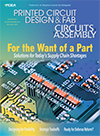Can AI Effectively Quote High-Mix, Low-to-Medium Volume PCBs?
 It’s getting closer, but not there yet.
It’s getting closer, but not there yet.
Quoting printed circuit boards – especially for high-mix, low-to-medium volume requirements – can be extremely time-consuming and, at times, mentally challenging. That’s especially true in these days of frequently changing tariffs, when many prospects are just kicking the tires in search of better pricing.
I have found many US PCB fabricators slower than their offshore counterparts in responding to requests for quotes. But that’s not from lack of trying. Between balancing innerlayer stackups, calculating specialty via drill costs, and accounting for ever-changing material prices, quoting a bare board isn’t just a spreadsheet task anymore.
In addition, the push to bring back or increase domestic manufacturing has exposed the limited capacity of many fabricators’ quoting departments meaning they have to be more selective on which customers and prospective customers to prioritize, even if that means missing out on a new opportunity.
So naturally, the question arises: Can artificial intelligence reduce the PCB quoting workload?
AI is already transforming supply chain forecasting, predictive maintenance, and even design for manufacturability (DfM). But when it comes to quoting circuit boards –especially in our niche of high mix and non-mass production – the jury is still out. Can AI truly grasp the nuances of quoting, or is it just a fast-talking assistant that doesn’t truly understand the game?
AI is a pattern-recognition engine. Feed it enough data – past quotes, order history, supplier pricing – and it can analyze in seconds what might take a human hours or even days. AI doesn’t get tired, doesn’t need coffee breaks, doesn’t hit a wall halfway through quoting a 12-layer RF board with blind vias.
For fabricators that handle a high volume of quote requests, AI may help triage the simple jobs quickly, freeing up human estimators to focus on the truly complex builds. This kind of scalability is especially useful in customer-facing quoting portals, where expectations for turnaround time are shrinking.
AI algorithms are increasingly good at scraping databases, analyzing lead times, pricing history, and MOQ requirements. And if the fabricator offers a global manufacturing solution, AI could even quote the same board through multiple quoting pathways (domestic in-house versus offshore economy, for example).
That’s not just automation. It’s decision support at scale.
A big ‘however.’ The big challenge in high-mix, low-to-medium volume quoting, however, is that every job is as different as the customer being quoted. Maybe the print says IPC Class 3, but the customer wants IPC Class “2.5” and also insists on a low-cost offshore build. Maybe the Gerber files suggest standard laminate, but the reliability spec screams for material with a higher Tg.
AI also might fail to take into consideration the human aspect of doing business, like a particular buyer who is longstanding and pleasant to work with receives favorable (lower) pricing, while a buyer at another customer who is difficult to work with receives not-so-favorable (higher) pricing.
AI often struggles with these contextual contradictions – things an experienced estimator would spot or know instantly. Granted, the “favorable” customers could be tagged in a way identifiable to the AI. But even that would require ongoing human involvement.
In other words, AI can crunch the numbers, but it doesn’t read between the lines well – yet.
Another issue is that AI is only as smart as the data it’s trained on. If the quoting history is full of outdated pricing or tribal knowledge stored only in someone’s head, then the AI will simply scale up those inefficiencies.
Getting to the point where AI adds real quoting value often requires a heavy lift in data hygiene, ERP integration and human supervision. That’s not plug-and-play. It’s a commitment.
While AI is making inroads in DfM and CAM analysis, quoting still demands a level of technical nuance and practical judgment. Can AI catch all that, interpret it and price it appropriately? Maybe it can or will soon be able to do so. But I don’t think we’re there yet.
This is especially true when dealing with aerospace, medical or military applications, domains where quoting mistakes aren’t just expensive; they could be catastrophic.
Going back to the original question: Can AI quote high-mix, low-to-medium volume PCBs effectively?
Several software options on the market are trying to automate PCB quoting for PCB fabricator and contract manufacturers. While not perfect, they promise to be excellent tools for accelerating routine quotes, suggesting pricing boundaries, and identifying possible cost anomalies. AI is already proving valuable in streamlining early-stage quote triage and supporting the quoting department with data insights.
But it’s not a silver bullet. Human expertise, based on well-rounded experience, remains essential for quoting complex PCBs. Using AI to augment a fab house’s quoting processes would be preferable at this time. Think of AI as a well-trained assistant: fast, reliable and good at math, but still in need of a supervisor who understands the business, customers and consequences.
We will likely see hybrid models take center stage: AI generates the first-pass quote, flags areas of concern, and hands it off to a human for final tuning. This strikes a balance between speed and accuracy, and keeps the human touch where it matters most.
has more than 25 years’ experience selling PCBs directly for various fabricators and as founder of a leading distributor. He is cofounder of DirectPCB (directpcb.com); greg@directpcb.com.
Press Releases
- Coherix Opens New Adhesive-Dispensing Vision Center in Europe
- Pan Pacific Strategic Electronics Symposium Program Finalized
- The Most Critical 2 Inches in SMT Manufacturing – When a Splice Fails, the Line Fails, Full Stop. Throughput and Yield Depend on One Overlooked Moment
- Entrepix Signs Exclusive Representative Agreement with Legatech for the United Kingdom and Nordic Region







